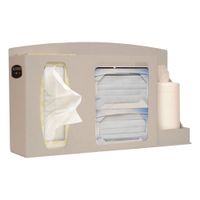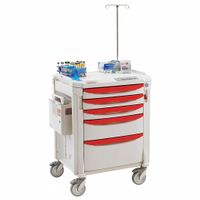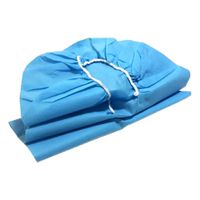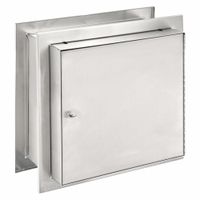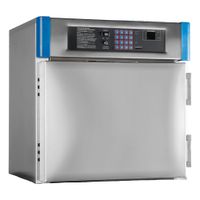Call +(254) 703 030 000 / 751 483 999 / 721 704 777
- Home
- Safety
- Medical Supplies Equipment
- Exam Room Furnishings
.....Read More
Frequently Asked Questions
What are the essential furnishings needed for an exam room to ensure a functional and professional space for patient care?
An exam room should be equipped with essential furnishings to ensure it is functional and professional for patient care. Key elements include:
1. **Examination Table**: A height-adjustable, comfortable examination table with a paper roll for hygiene is crucial for patient assessments.
2. **Seating**: Comfortable chairs for both the patient and the healthcare provider are necessary. A stool with wheels for the provider allows easy movement.
3. **Storage Solutions**: Cabinets and drawers for storing medical supplies, instruments, and personal protective equipment (PPE) keep the room organized and efficient.
4. **Lighting**: Adjustable overhead and task lighting ensure proper visibility for examinations and procedures.
5. **Diagnostic Equipment**: Wall-mounted or portable diagnostic tools such as an otoscope, ophthalmoscope, blood pressure monitor, and thermometer are essential for routine checks.
6. **Hand Hygiene Station**: A sink with soap and hand sanitizer dispensers promotes infection control.
7. **Waste Disposal**: Biohazard and regular waste bins, along with a sharps container, are necessary for safe disposal of medical waste.
8. **Privacy Features**: Curtains or screens provide patient privacy during examinations.
9. **Technology**: A computer or tablet for accessing electronic health records (EHR) and documenting patient information is vital.
10. **Emergency Equipment**: Basic emergency equipment like a first aid kit and an automated external defibrillator (AED) should be accessible.
11. **Decor and Comfort Items**: Neutral decor, artwork, and a clock create a calming environment, while tissues and magazines offer comfort and distraction.
These elements collectively ensure the exam room is equipped to provide high-quality patient care in a professional setting.
How do healthcare dispensers help in organizing medical garments, consumables, and medications?
Healthcare dispensers play a crucial role in organizing medical garments, consumables, and medications by providing systematic storage, easy access, and efficient inventory management. These dispensers are designed to categorize and store items in a manner that enhances workflow and reduces the risk of errors.
For medical garments, dispensers ensure that items such as gowns, gloves, and masks are stored in a clean, organized manner, often in a sterile environment. This organization helps in maintaining hygiene standards and ensures that healthcare professionals can quickly access the necessary garments without delay, especially in emergency situations.
When it comes to consumables like syringes, bandages, and IV supplies, dispensers help in categorizing these items based on size, type, or usage frequency. This categorization minimizes the time spent searching for specific items, thereby increasing efficiency and allowing healthcare providers to focus more on patient care.
For medications, dispensers are often integrated with electronic systems that track inventory levels, expiration dates, and usage patterns. Automated medication dispensers can dispense the correct dosage at the right time, reducing the risk of medication errors. They also provide secure storage, ensuring that only authorized personnel have access to controlled substances.
Overall, healthcare dispensers contribute to a streamlined workflow by reducing clutter, ensuring compliance with health regulations, and enhancing the overall efficiency of healthcare facilities. They support inventory management by providing real-time data on stock levels, which aids in timely reordering and reduces waste due to expired or overstocked items. This organization ultimately leads to improved patient safety and care quality.
What are the benefits of using over-the-bed tables in patient care?
Over-the-bed tables offer several benefits in patient care, enhancing both comfort and functionality. They provide a stable and adjustable surface for patients to eat meals, which is crucial for those with limited mobility or who are bedridden. This accessibility promotes better nutrition and hydration, as patients can easily reach their food and drinks.
These tables also facilitate personal activities, such as reading, writing, or using electronic devices, which can improve a patient's mental well-being by allowing them to engage in leisure activities or stay connected with loved ones. The ability to adjust the height and angle of the table ensures ergonomic support, reducing strain on the patient.
For healthcare providers, over-the-bed tables serve as a convenient platform for medical equipment and supplies, streamlining the delivery of care. They can hold items like medication, charts, or monitoring devices, keeping essential tools within easy reach and organized, which enhances efficiency and reduces the risk of errors.
Infection control is another benefit, as these tables are typically designed with materials that are easy to clean and disinfect, minimizing the risk of cross-contamination. This is particularly important in hospital settings where infection control is a priority.
Moreover, over-the-bed tables can be used in various healthcare settings, from hospitals to home care, offering versatility and adaptability to different patient needs. Their mobility allows for easy repositioning, accommodating different activities and patient positions.
Overall, over-the-bed tables contribute to a more comfortable, efficient, and safe patient care environment, supporting both the physical and psychological needs of patients while aiding healthcare providers in delivering effective care.
How do blood-draw chairs improve the process of taking blood samples from patients?
Blood-draw chairs significantly enhance the process of taking blood samples by providing comfort, safety, and efficiency for both patients and healthcare professionals. These chairs are ergonomically designed to ensure patient comfort, which is crucial in reducing anxiety and discomfort during the procedure. The armrests are adjustable and padded, allowing for optimal positioning of the patient's arm, which facilitates easier access to veins and reduces the risk of complications such as hematomas.
For healthcare professionals, blood-draw chairs improve efficiency by providing a stable and accessible platform to perform venipuncture. The adjustable height feature allows phlebotomists to work at a comfortable level, minimizing strain and fatigue. This ergonomic advantage can lead to more precise and quicker procedures, reducing the time patients spend in the clinic and increasing the number of patients that can be seen.
Safety is another critical aspect improved by blood-draw chairs. Many models come equipped with features such as locking mechanisms and non-slip surfaces to prevent accidents. Some chairs also have integrated safety belts or arm restraints to secure patients who may be prone to fainting or sudden movements, thereby preventing injury.
Additionally, blood-draw chairs often have easy-to-clean surfaces, which is essential for maintaining hygiene and preventing cross-contamination between patients. This feature is particularly important in healthcare settings where infection control is a priority.
Overall, blood-draw chairs streamline the blood collection process by enhancing patient comfort, improving procedural efficiency, and ensuring safety and hygiene, ultimately leading to better patient experiences and outcomes.
What is the purpose of medical privacy screens in exam rooms?
Medical privacy screens in exam rooms serve several important purposes:
1. **Patient Privacy and Dignity**: They provide a physical barrier that ensures patients' privacy during medical examinations, treatments, or consultations. This helps maintain the dignity of patients by shielding them from the view of others, including other patients, staff, or visitors.
2. **Confidentiality**: Privacy screens help in maintaining the confidentiality of the patient’s medical information and discussions. By creating a private space, they prevent unauthorized individuals from overhearing sensitive conversations between patients and healthcare providers.
3. **Comfort and Security**: The presence of a privacy screen can make patients feel more comfortable and secure, reducing anxiety and stress during medical visits. This is particularly important in situations where patients may need to undress or undergo intimate examinations.
4. **Infection Control**: Some privacy screens are designed with materials that are easy to clean and disinfect, contributing to infection control measures within healthcare settings. This is crucial in preventing the spread of infections and maintaining a sterile environment.
5. **Space Management**: In facilities with limited space, privacy screens can be used to create temporary partitions, allowing multiple patients to be seen in the same room without compromising privacy. This flexibility is beneficial in busy clinics or during emergencies.
6. **Professional Environment**: They contribute to a professional and organized environment, which can enhance the overall experience for both patients and healthcare providers. A well-structured space can improve workflow efficiency and patient throughput.
In summary, medical privacy screens are essential for ensuring privacy, confidentiality, comfort, and infection control in exam rooms, while also aiding in efficient space management and maintaining a professional healthcare environment.
How do medical gurney sheets and pillowcases contribute to patient comfort and hygiene?
Medical gurney sheets and pillowcases play a crucial role in enhancing patient comfort and maintaining hygiene in healthcare settings. These linens are designed to provide a soft, clean surface for patients, which is essential for comfort, especially for those who may be bedridden or require extended periods of rest. The materials used are typically breathable and gentle on the skin, reducing the risk of irritation or pressure sores, which can occur with prolonged contact with rough or unclean surfaces.
From a hygiene perspective, gurney sheets and pillowcases are vital in preventing the spread of infections. They act as a barrier between the patient and the gurney or pillow, which can harbor bacteria and other pathogens. Regular changing and laundering of these linens ensure that any contaminants are removed, thereby reducing the risk of cross-contamination between patients. This is particularly important in hospitals where patients may have compromised immune systems.
Moreover, the use of hypoallergenic materials in these linens can prevent allergic reactions, further contributing to patient comfort. The ability to easily change and sanitize these linens also allows healthcare providers to quickly prepare for new patients, ensuring a clean and welcoming environment.
In summary, medical gurney sheets and pillowcases are essential for providing a comfortable and hygienic experience for patients. They help prevent skin issues, reduce the risk of infection, and ensure a clean environment, all of which are critical components of patient care in medical facilities.
What are the advantages of using medical carts and cabinets for storing and transporting medical supplies?
Medical carts and cabinets offer numerous advantages for storing and transporting medical supplies. They enhance organization by providing designated spaces for various items, reducing clutter and making it easier for healthcare professionals to locate necessary supplies quickly. This organization improves efficiency, allowing medical staff to spend more time on patient care rather than searching for equipment.
These storage solutions also improve mobility. Medical carts, often equipped with wheels, allow for easy transportation of supplies throughout a healthcare facility. This mobility is crucial in emergency situations where time is of the essence, enabling rapid response and delivery of necessary equipment to different areas.
Security is another significant advantage. Many medical carts and cabinets come with locking mechanisms to secure sensitive or controlled substances, ensuring that only authorized personnel have access. This feature helps in maintaining compliance with regulations and preventing theft or misuse of medical supplies.
Infection control is enhanced through the use of medical carts and cabinets. They are often designed with materials that are easy to clean and disinfect, reducing the risk of cross-contamination and maintaining a sterile environment. This is particularly important in healthcare settings where infection control is a top priority.
Customization options allow these storage solutions to be tailored to specific needs. Medical carts and cabinets can be configured with various drawers, shelves, and compartments to accommodate different types of supplies, from medications to surgical instruments, enhancing their versatility.
Overall, medical carts and cabinets contribute to a more organized, efficient, and safe healthcare environment, ultimately supporting better patient care and operational effectiveness.


